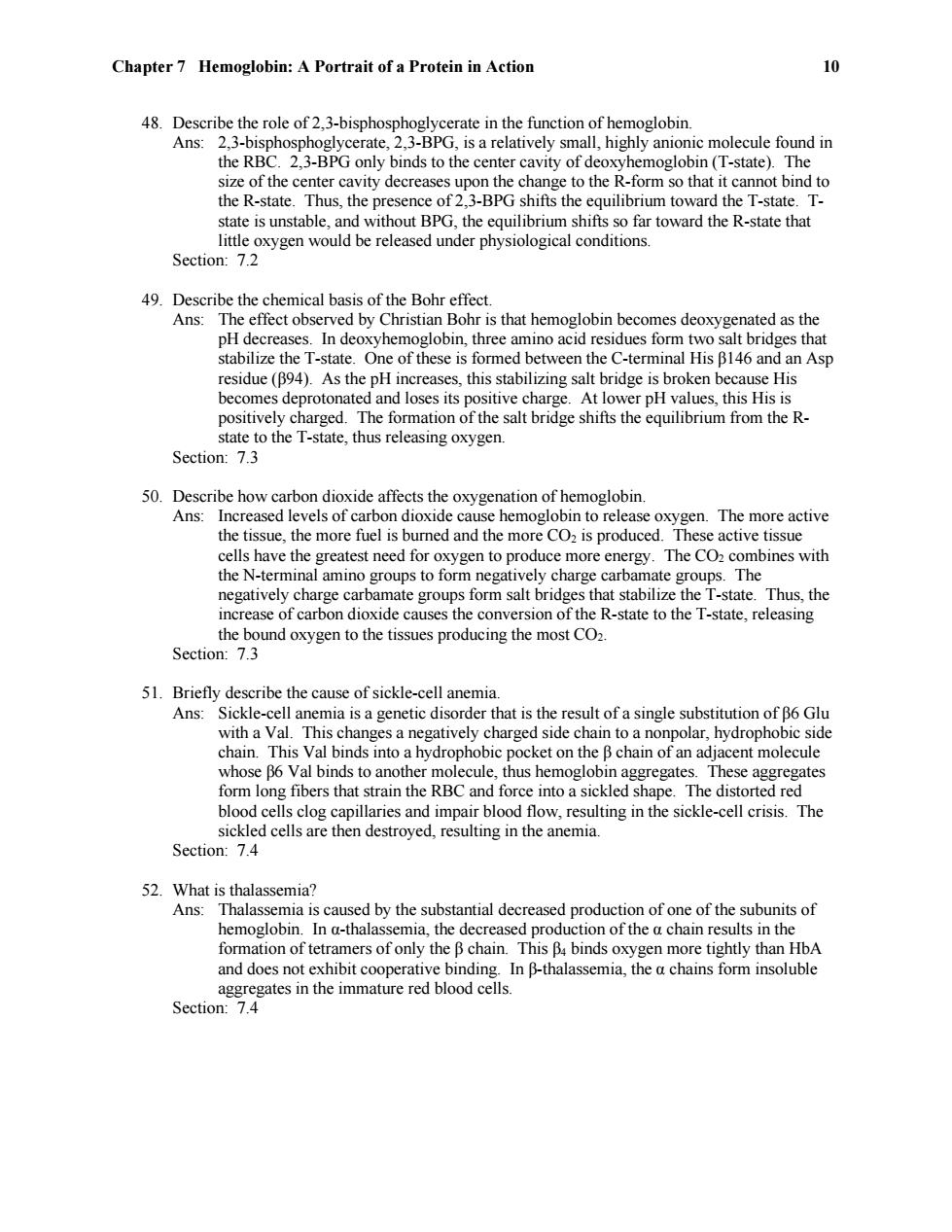正在加载图片...

Chapter 7 Hemoglobin:A Portrait of a Protein in Action 10 48.Describe the role of 2,3-bisphosphoglycerate in the function of hemoglobin. Ans:2.3-bisphosphoglycerate,2,3-BPG,is a relatively small,highly anionic molecule found in the RBC.2,3-BPG only binds to the center cavity of deoxyhemoglobin(T-state).The size of the center cavity decreases upon the change to the R-form so that it cannot bind to the R-state.Thus,the presence of 2,3-BPG shifts the equilibrium toward the T-state.T- state is unstable.and without BPG.the equilibrium shifts so far toward the R-state that little oxygen would be released under physiological conditions. Section:7.2 49.Describe the chemical basis of the Bohr effect. Ans:The effect observed by Christian Bohr is that hemoglobin becomes deoxygenated as the pH decreases.In deoxyhemoglobin,three amino acid residues form two salt bridges that stabilize the T-state.One of these is formed between the C-terminal His B146 and an Asp residue(B94).As the pH increases,this stabilizing salt bridge is broken because His becomes deprotonated and loses its positive charge.At lower pH values,this His is positively charged.The formation of the salt bridge shifts the equilibrium from the R- state to the T-state,thus releasing oxygen. Section:7.3 50.Describe how carbon dioxide affects the oxygenation of hemoglobin. Ans:Increased levels of carbon dioxide cause hemoglobin to release oxygen.The more active the tissue,the more fuel is burned and the more CO2 is produced.These active tissue cells have the greatest need for oxygen to produce more energy.The CO2 combines with the N-terminal amino groups to form negatively charge carbamate groups.The negatively charge carbamate groups form salt bridges that stabilize the T-state.Thus,the increase of carbon dioxide causes the conversion of the R-state to the T-state,releasing the bound oxygen to the tissues producing the most CO2. Section:7.3 51.Briefly describe the cause of sickle-cell anemia. Ans:Sickle-cell anemia is a genetic disorder that is the result of a single substitution of B6 Glu with a Val.This changes a negatively charged side chain to a nonpolar,hydrophobic side chain.This Val binds into a hydrophobic pocket on the B chain of an adjacent molecule whose B6 Val binds to another molecule,thus hemoglobin aggregates.These aggregates form long fibers that strain the RBC and force into a sickled shape.The distorted red blood cells clog capillaries and impair blood flow,resulting in the sickle-cell crisis.The sickled cells are then destroyed,resulting in the anemia. Section:7.4 52.What is thalassemia? Ans:Thalassemia is caused by the substantial decreased production of one of the subunits of hemoglobin.In a-thalassemia,the decreased production of the a chain results in the formation of tetramers of only the B chain.This B4 binds oxygen more tightly than HbA and does not exhibit cooperative binding.In B-thalassemia,the a chains form insoluble aggregates in the immature red blood cells. Section:7.4Chapter 7 Hemoglobin: A Portrait of a Protein in Action 10 48. Describe the role of 2,3-bisphosphoglycerate in the function of hemoglobin. Ans: 2,3-bisphosphoglycerate, 2,3-BPG, is a relatively small, highly anionic molecule found in the RBC. 2,3-BPG only binds to the center cavity of deoxyhemoglobin (T-state). The size of the center cavity decreases upon the change to the R-form so that it cannot bind to the R-state. Thus, the presence of 2,3-BPG shifts the equilibrium toward the T-state. T- state is unstable, and without BPG, the equilibrium shifts so far toward the R-state that little oxygen would be released under physiological conditions. Section: 7.2 49. Describe the chemical basis of the Bohr effect. Ans: The effect observed by Christian Bohr is that hemoglobin becomes deoxygenated as the pH decreases. In deoxyhemoglobin, three amino acid residues form two salt bridges that stabilize the T-state. One of these is formed between the C-terminal His β146 and an Asp residue (β94). As the pH increases, this stabilizing salt bridge is broken because His becomes deprotonated and loses its positive charge. At lower pH values, this His is positively charged. The formation of the salt bridge shifts the equilibrium from the R- state to the T-state, thus releasing oxygen. Section: 7.3 50. Describe how carbon dioxide affects the oxygenation of hemoglobin. Ans: Increased levels of carbon dioxide cause hemoglobin to release oxygen. The more active the tissue, the more fuel is burned and the more CO2 is produced. These active tissue cells have the greatest need for oxygen to produce more energy. The CO2 combines with the N-terminal amino groups to form negatively charge carbamate groups. The negatively charge carbamate groups form salt bridges that stabilize the T-state. Thus, the increase of carbon dioxide causes the conversion of the R-state to the T-state, releasing the bound oxygen to the tissues producing the most CO2. Section: 7.3 51. Briefly describe the cause of sickle-cell anemia. Ans: Sickle-cell anemia is a genetic disorder that is the result of a single substitution of β6 Glu with a Val. This changes a negatively charged side chain to a nonpolar, hydrophobic side chain. This Val binds into a hydrophobic pocket on the β chain of an adjacent molecule whose β6 Val binds to another molecule, thus hemoglobin aggregates. These aggregates form long fibers that strain the RBC and force into a sickled shape. The distorted red blood cells clog capillaries and impair blood flow, resulting in the sickle-cell crisis. The sickled cells are then destroyed, resulting in the anemia. Section: 7.4 52. What is thalassemia? Ans: Thalassemia is caused by the substantial decreased production of one of the subunits of hemoglobin. In α-thalassemia, the decreased production of the α chain results in the formation of tetramers of only the β chain. This β4 binds oxygen more tightly than HbA and does not exhibit cooperative binding. In β-thalassemia, the α chains form insoluble aggregates in the immature red blood cells. Section: 7.4